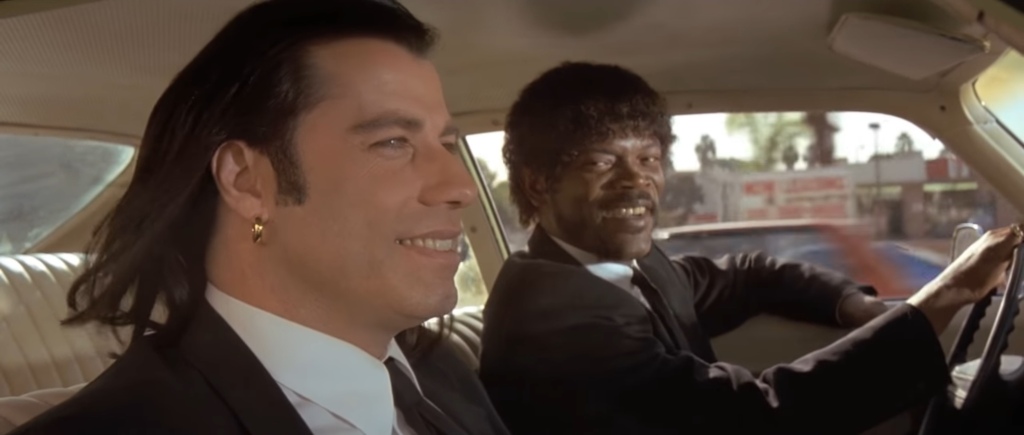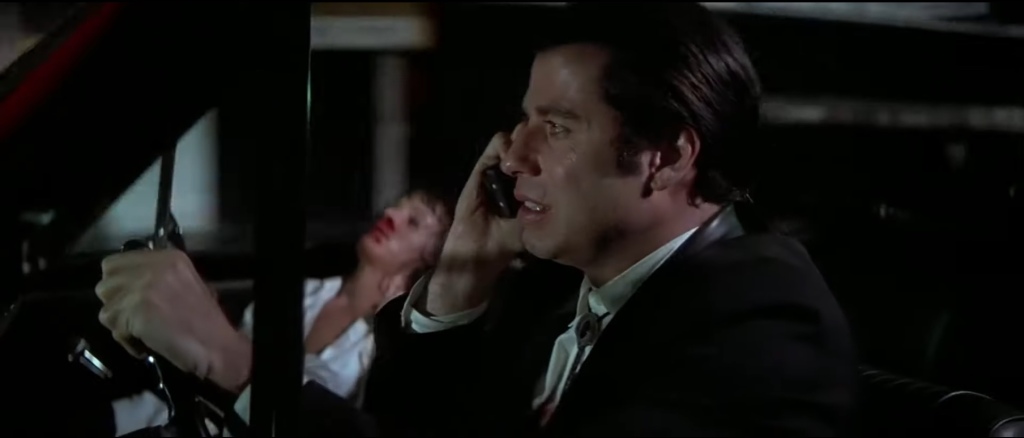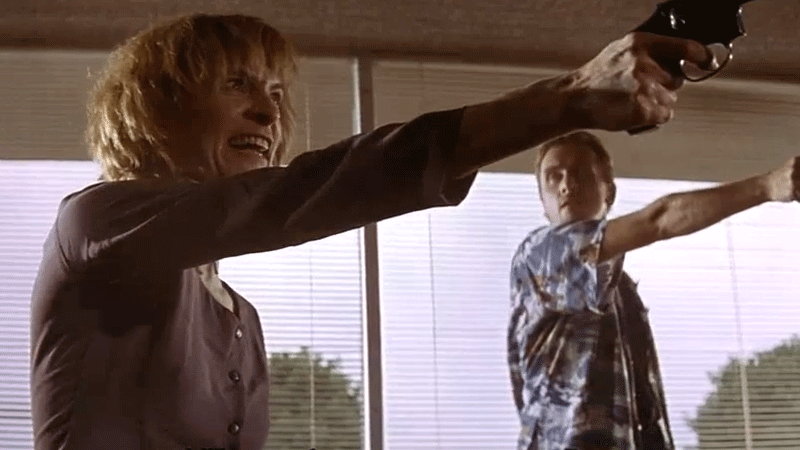Quentin Tarantino utilises a variety of narrative techniques in order to propel the plot forward in enthralling and captivating ways.
Dialogue
Throughout Tarantino’s filmography, densely-packed dialogue is a keystone of Tarantino’s body of work. The characters often monologue about seemingly trivial topics, including: burgers, divine intervention, and foot massages. Tarantino’s dialogue is also peppered with pop culture references to brands such as Big Mac, bands like Kool and the Gang (who also feature in the compiled score), and TV shows such as “Green Acres”. The dialogue is entertaining and enjoyable to listen to, despite the fact that it does not drive the plot forward in any way. The viewer receives entertainment from listening in on these everyday conversations, especially from characters that you wouldn’t expect to discuss such trivial matters.
Through this, the rhythm of the film flows in a refreshing manner. Since Vincent and Jules’ journey to the apartment takes up a similar amount of screen time to the events that unfold within the flat itself, the viewer’s perception of time is shifted. The characters, which initially appear to be hollow and one-noted, are also fleshed out through these seemingly mundane conversation topics.

Character Motivations
Character motivations are defined as the driving force behind a character’s actions. These are fundamental to the viewer’s understanding of and engagement with the meanings behind the events that occur throughout the film. During Pulp Fiction, Tarantino’s aforementioned dialogue facilitates the characters’ motivations and thus, the overall narrative drive of the film.
For example, after we learn about the seemingly trivial foot massage incident, in which Tony Rocky Horror was thrown out of a window, we are able to understand and empathise with Vincent’s apprehensiveness towards taking out Mia for the night. This motivation helps drastically increase the tension during Mia’s overdose, as the viewer is left to ponder the consequences of Marsellus discovering the truth. Another example of motivations aiding the narrative drive of the film is Captain Koons’ monologue to a young Butch about the gold watch, prompting Butch to return to his apartment to reclaim it.

Cause and Effect
This idea is defined as “something that triggers an event or action (cause) and its consequences (effect)”. All films are constructed around this fundamental idea, beginning with an inciting incident and thus enacting a chain of events to be set in motion. For example, Vincent and Jules are assigned by Marsellus Wallace to collect a mysterious briefcase from an apartment. This inciting incident ultimately leads to each of the events that occur during their storyline to take place. The vividly realised and nuanced characters present within Pulp Fiction allow the cause and effect to be highly specific and esoteric throughout.
Pacing
Pacing is defined as “the rhythm at which the plot unfolds”. Being widely overlooked by many, pacing can effect the foundations of a film’s rhythm in drastic ways. An action film is typically very fast-paced, as it attempts to keep the viewer engaged with an array of high-octane sequences. Conversely, a mystery film might be more paced in a slower, more deliberate manner in order to try and keep the viewer in anticipation for as long as possible.
Tarantino deliberately paces his films in a highly unorthodox and unique manner, subverting the viewer’s expectations in the process. To elaborate, seemingly unimportant and self-indulgent scenes take up a large chunk of screen time. These include the likes of Jules and Vincent’s drive to the apartment, Captain Koons’ watch monologue, as well as Mia and Vincent’s conversation in the diner. Conversely, crucially important plot events are over in a matter of seconds – examples including Vincent shooting Marvin in the face and Vincent’s sudden death. Additionally, the viewer is subjected to Pumpkin and Honey Bunny’s meandering conversation about armed robberies at the beginning of the film, which ultimately builds up to the diner robbery. However, Tarantino teases the viewer by not showing us the aftermath of the couple holding up the restaurant until the very end of the film. In effect, this keeps the audience engaged in this plot thread up until the very end of the film, during which the robbery is finally displayed to us.

Chronological Flow
This idea is defined as “the arrangement of things following one after another in time”. The narrative of the Pulp Fiction is relatively simple, with the film containing four episodic chapters with interconnected characters and events. On the other hand, the plot of the film is constructed in a highly nonlinear and convoluted manner. Although each chapter itself has a linear structure, the order in which it is shown to the viewer is non-chronological. This fragmentation of the plot creates an underlying sense of anticipation. Due to the fact that the viewer is witnessing events out of order, we expect to see the repercussions of these events later in the film.